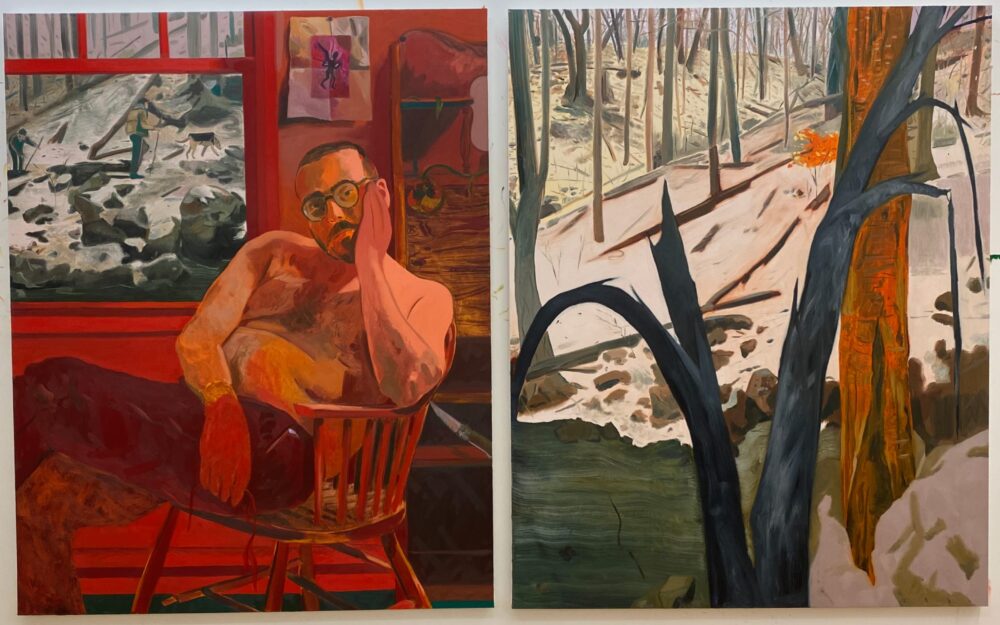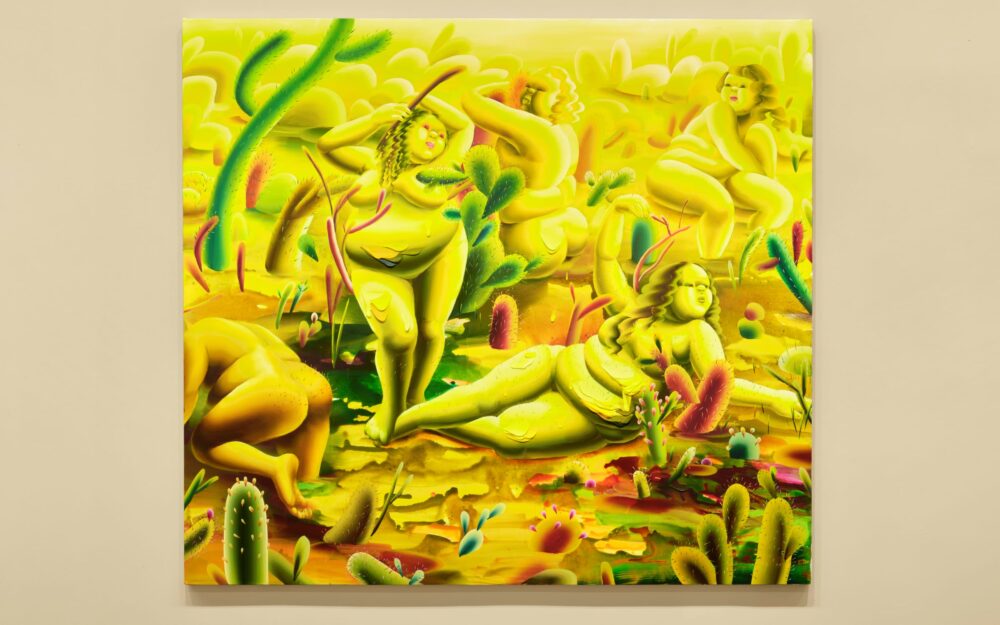
- Source: ART BASEL
- Author: STEPHANIE BAILEY
- Date: JULY 6, 2023
- Format: DIGITAL
How artists are redefining identity through painting in the 21st century
In Shanghai, a group show spotlights painters like Tunji Adeniyi-Jones, Michaela Yearwood-Dan, and Jonny Negron, whose canvases hold space for fluidity and transformation
Hanging from Pond Society’s stone facade in Shanghai is a banner showing one half of Anthony Cudahy’s oil on canvas diptych, projection/riven (2023). In loose yet faithful strokes, the artist is shown sitting in a room flushed with warm red light, looking out to the viewer as if inviting them into their private world. That invitation expands inside the gallery, which was founded in 2017 by collector Xue Bing as a platform for artistic exchange. There, the second half of Cudahy’s composition centers a cracked branch in a snowy woodland like a figure, as part of ‘Public Private’, a two-chapter summer show curated by Dr Jareh Das to explore how traditional painting genres like portraiture are being redefined in the present.
Of course, artists across generations and geographies have long pushed back on an art history dominated by colonial modernity and its canons, where figures and lands were rendered as subjects and zones of control. ‘Public Private’, tracks these movements in the 21st century through works by 12 contemporary painters from around the world, including GaHee Park and Caroline Walker, who are each using the canvas to challenge rigid perspectives on what it means to exist in the world today.

Anthony Cudahay, projection/riven, 2023. Courtesy of the artist and Hales Gallery.
What emerges is a return to source – that is, to an understanding of the world as something commonly shared yet uniquely experienced in all its non-aligned complexity. Take Tunji Adeniyi-Jones’s oil on canvas Triple Dive Red II (2023): blood-orange bodies materialize from a swirling grid of tangerine leaves to create a Euclidian plane where two- and three-dimensions settle into quivering, non-hierarchical interrelations. This geometric field is exemplary of the fluid, transcultural geometries that inform Adeniyi-Jones’s diasporic aesthetic, which he describes as ‘a vast universe, consisting of both individual and collective thought patterns and expressions.’
Adeniyi-Jones says he spent a decade in America trying to ‘unwind the tight knot’ of a ‘regimented art education in the UK.’ From Yoruba deities, the 19th-century Arts and Crafts movement in Britain, and Jenny Saville to the overlapping silhouettes of Harlem Renaissance pioneer Aaron Douglas and Lee Krasner’s expressionist abstractions, his compositions illuminate the enmeshments that have shaped his practice in a world defined by its entanglements. ‘I feel deeply connected to the legacies of artists like Frank Bowling, who spent much of his early career documenting the richly complex cultural identity of himself and those around him,’ the artist notes.
By collapsing references in his paintings, Adeniyi-Jones circumvents the tendencies of reductive identification that Michaela Yearwood-Dan likewise evades with each expressive stroke. Building a formation that invokes the birth of a star, In times of doubt (2023) combines pink, green, and yellow planes of oil paint and pastel with fields of glass beadwork on canvas. Sweeping curls of midnight black hold this ordered chaos together, hinting at the artist’s conscious dissolution of the figure to resist the inclination to read an artwork by projecting a singular identity onto its maker.
As Yearwood-Dan has pointed out, discussions on representation tend to focus on ‘who we are seeing, what we are seeing and what it looks like, rather than perhaps a more introspective type of representation.’ Far from insular, this introspection opens up aesthetic and conceptual worlds, because it makes space for an artist to speak to an audience in terms of form, materiality, and process. ‘There is something about being able to work in layers and sections to see a final product emerge, and having an idea in your head that you ultimately need to surrender at some point along the way…’ Yearwood-Dan explains. That surrender highlights the introspective representation Yearwood-Dan describes, because it honors existence as an intimate, embodied, yet profoundly expansive and elastic experience that could never be truly contained nor captured.
Dominic Chambers’s oil on linen Warm Morning (2023) likewise illuminates that boundlessness. A Black figure creates a silhouette along the window ledge they sit on, framing a magnificent orange cloudscape across which birds fly freely. In relation to a similar composition, Window Sitter (Daybreak) (2021), Chambers has described an aim ‘to provide a scene of a Black subject peering out of the window and into a space where one’s circumstances (political or environmental) cease to be a concern.’ This untethering of subjectivity transforms the subject and metamorphosizes its context, because external conditions lose the monopoly on defining what someone or something is. ‘Windows gives us poetry and remind us that the world offers itself to our imagination,’ Chambers points out. ‘Peering into those transparent portals, the window becomes a site for meditative reflection – on a day, a concern, or idea.’

Hyegyeong Choi, Prickly Women, 2023. Photography by Hong Zhang. Courtesy of Pond Society © Pond Society.
Creating portals for imaginative reflection is what unites each artist in ‘Public Private’. In Hyegyeong Choi’s acid-yellow Prickly Women (2023), an arresting range of acrylic dollops and strokes build the voluptuous bodies of naked women on a canvas measuring roughly 2 by 2 meters. The group lounges around a pool in a cacti-filled landscape, unbothered by needles puncturing their skin. Their empowering indifference – which Choi connects to her ‘struggle to look and behave a certain way while growing up in Korea’ – finds a foil in Sarah Slappey’s oil on canvas Slip and Fall (2023). The painting turns a shaving accident into an allegory executed with the dramatic symbolism of a Renaissance altarpiece. Suspended mid-tumble, chrome-pink-to-steel-blue legs are entangled by a transparent curtain, as a green razor hovers between anxious hands. Alluding to the formalist grid, white-tiled shower walls speckled with blue and blood-pink splashes close in on the scene.
Here, beauty becomes an absurd pursuit dictated by external pressures. Jonny Negron distils that burden in two flame-toned paintings, each magnifying the intense emotional charge that unobtainable ideals can trigger when communicated through the representations of dominant cultures, whether in classical painting or commercial advertising. In Poison (2023), an orange hand holds an apple-shaped bottle of Dior’s eponymous perfume like a gemstone, its silver cap glinting like the North Star. In Vitriol (2023), a muscular body is accentuated by a rippling orange shirt burning at the arms, which shield the figure’s face save for an angry eye glaring from behind one hand. The work’s title is painted below in bright yellow caps, highlighting its double meaning as sulfuric acid and acidic fury, which circles back to the painting’s seething character.
Negron associates these paintings with the idea of anger calcifying into poisonous resentment, and the importance of redirecting wrath towards transformation. This alchemical call to convert rage into revolution strikes at the heart of ‘Public Private’. In this transcultural gathering of painters, the canvas transcends into an open-ended universe populated by autonomous beings rather than defined subjects.
‘Public Private’, curated by Dr Jareh Das, features Tunji Adeniyi-Jones, Hayley Barker, Dominic Chambers, Hyegyeong Choi, Anthony Cudahy, Ulala Imai, Sarah Lee, Jonny Negron, GaHee Park, Sarah Slappey, Caroline Walker, and Michaela Yearwood-Dan.
‘Public Private’
Pond Society, Shanghai
Part I: June 10 – July 20, 2023
Part II: July 29 – September 7, 2023

